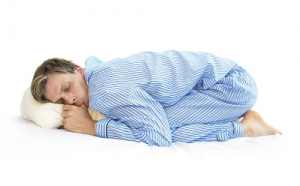
Everyone has their preferred sleeping position but if you are carrying an injury, or you suffer from ongoing back or neck pain, some are better than others. There is no one right position for sleeping but generally speaking, when you are sleeping the aim is to keep the body in a neutral position.
when you are sleeping the aim is to keep the body in a neutral position
This means you do not want any joint to be in an abnormal position with muscles being in a lengthened
or
shortened position. Depending on the injury
or medical condition you are suffering from, changing the way you sleep may prevent it from getting worst or even alleviate the symptoms completely. Sleeping in one position every night can also cause symptoms.
The most common sleeping position is the foetal position which is quite curled up and on one’s side. 41% of people adopt this position. The foetal position can be uncomfortable for anyone with back pain due to the twisting involved. The use of a pillow between your knees can be a very simple way to reduce the rotation of the spine.
Sleeping on your back may cause back pain as a result of the pressure put on the joints as it flattens the natural curves of the back. This position can also increase the chances of apnoea (cessation of breathing caused by blockage or narrowing of airways), and snoring. If you are set in your ways and cannot get comfortable in any other position, the use of a pillow under your knees can improve the natural curve of your spine. If this is not enough to resolve symptoms, having a rolled up sheet placed in the small of your back with some elevation of the head can also be a useful solution.
The most common injury associated with stomach sleepers is pain in the neck from prolonged end range twisting through the neck joints. This may also be associated with the onset of wry neck. A simple strategy that can reduce the amount of twisting is by using a very shallow pillow or no pillow at all.
 What to do?
What to do?Each injury is unique and responds in different ways to different positions. A consultation with your physiotherapist can include advice on which sleeping position will best suit you. Changing the way you position yourself when you sleep can be a hard task however there are a number of strategy’s we use to help. For example: sewing a tennis ball onto the back of a pyjama shirt for a habitual back sleeper acts as a good reminder in the middle of the night.
Do you need more information about the best pillow option? Check out this Choice article for the results of their survey.

Dale Rolfe is a Physiotherapist at The Healthy Body Company in Jordan Springs. He also works as a sports physiotherapist for the Western Sydney Wanderers and NSW and Australian Touch Football. If you enjoyed this article by Dale you might want to look at some of these: